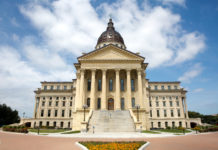In the past four months, there have been two IJ’s with nursing home providers (not in Kansas) that had locked kitchens at night. Fires occurred in the locked areas and no staff on duty had keys. In one case the staff arrived within eight minutes and in the second case, the staff arrived within 10-15 minutes. In both cases, staff response was also an issue.
Section 7.1.1.1.3.1 requires that even means of egress doors in a building that is not considered occupied, are not to be locked beyond the control of occupants in building spaces, except for lockups. Means of egress is defined from any point in a building.
18/19.2.2.2.1 Doors complying with 7.2.1 shall be permitted.
7.2.1.1.3 Occupied Building.
7.2.1.1.3.1 For the purposes of Section 7.2, a building shall be considered to be occupied at any time it meets any of the following criteria:
(1) It is open for general occupancy.
(2) It is open to the public.
(3) It is occupied by more than 10 persons.
7.2.1.1.3.2 Where means of egress doors are locked in a building that is not considered occupied, occupants shall not be locked beyond their control in buildings or building spaces, except for lockups in accordance with 22.4.5 and 23.4.5, detention and correctional occupancies, and health care occupancies.
3.3.170* Means of Egress. A continuous and unobstructed way of travel from any point in a building or structure to a public way consisting of three separate and distinct parts:
(1) the exit access,
(2) the exit, and
(3) the exit discharge.
NFPA Standard: 2012 NFPA 101, 4.8.2.1* Emergency plans shall include the following: (1) Procedures for reporting of emergencies (2) Occupant and staff response to emergencies (3)*Evacuation procedures appropriate to the building, its occupancy, emergencies, and hazards (see Section 4.3)(4) Appropriateness of the use of elevators (5) Design and conduct of fire drills (6) Type and coverage of building fire protection systems (7) Other items required by the authority having jurisdiction
NFPA Standard: 2012 NFPA 101, 19.1.1.3.2 Because the safety of health care occupants cannot be ensured adequately by dependence on evacuation of the building, their protection from fire shall be provided by appropriate arrangement of facilities; adequate, trained staff; and development of operating and maintenance procedures composed of the following: (1) Design, construction, and compartmentation (2) Provision for detection, alarm, and extinguishment (3) Fire prevention procedures and planning, training, and drilling programs for the isolation of fire, transfer of occupants to areas of refuge, or evacuation of the building
NFPA Standard: 2012 NFPA 101, 19.7.2.1.1 For health care occupancies, the proper protection of patients shall require the prompt and effective response of health care personnel.
NFPA Standard: 2012 NFPA 101, 19.7.2.1.2 The basic response required of staff shall include the following:(1)Removal of all occupants directly involved with the fire emergency (2) Transmission of an appropriate fire alarm signal to warn other building occupants and summon staff (3) Confinement of the effects of the fire by closing doors to isolate the fire area (4) Relocation of patients as detailed in the health care occupancy’s fire safety plan
NFPA Standard: 2012 NFPA 101, 19.7.2.2 A written health care occupancy fire safety plan shall provide for all of the following: (1) Use of alarms (2) Transmission of alarms to fire department (3) Emergency phone call to fire department (4) Response to alarms (5) Isolation of fire (6) Evacuation of immediate area (7) Evacuation of smoke compartment (8) Preparation of floors and building for evacuation (9) Extinguishment of fire
NFPA Standard: 2012 NFPA 101, 19.1.1.3.1 All health care facilities shall be designed, constructed, maintained, and operated to minimize the possibility of a fire emergency requiring the evacuation of occupants.
Questions? Contact Joel Beckner, Office of the State Fire Marshal at (785) 296-0659.




